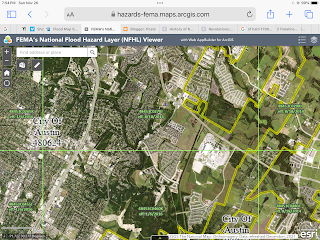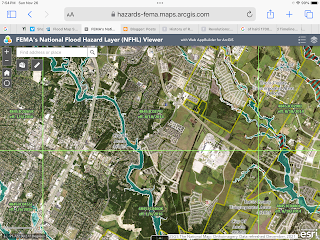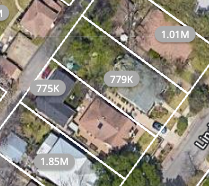Dear Council Members,
If you have been convinced that there is scientific data to support your goal of creating affordable housing through the H.O.M.E. initiative, I urge you -- at the very least -- to proceed cautiously by applying the new code changes to only a "study site" of Austin. In this way, you could hopefully determine if there are measurable results that match the intention of the HOME changes to land use code.
Here are some photos from satellite imagery for you to consider. They begin with the "big picture" of Austin geography and then I zoom-in to my street in my neighborhood, Bouldin Heights.
The urban heat island:
Urban heat island, zoom out:
Urban heat island, zoom out, with floodplains illustrated:
East Austin, zoom in: 6th Street urban heat island,
bounded by residential neighborhoods with tree canopies:
East Riverside, Austin, TX: Satellite image shows urban heat islands:
East Riverside, Austin, TX: Urban heat islands and floodplains:
Urbanization shows that residential neighborhoods provide tree canopies:
Floodplains of the area above:
Residential neighborhoods are essential green zones:
The same residential zones with floodplains, Shoal Creek:
This is my street in the Bouldin Heights neighborhood of Austin TX.
This residential lot was originally 6,244 SF.
A developer purchased the property, then divided it into 2 lots. The real 1/2 lot was sold, and a small house was built on it -- and later sold again. Now, each 1/2 lot is 3,122 SF.
The price for the ORIGINAL, UNDIVIDED LOT (6,244 SF).
The house in 2018, Zillow listed at $615K :
Now, the property has TWO houses, each valued by TravisCAD.org:
(1) $665K
(2) $721K
The small house in the rear was recently listed on Zillow for
rent at $4,500 per month.
Proof of current value as per TravisCAD.org:
Instead of creating AFFORDABLE housing,
the price of the small home now EQUALS
their next door neighbor's home value, an adjacent house on an original full-size lot
(as seen on this Zillow screenshot):
The current code seems to allow for considerable density uses.
For example, near my house there are three homes (photo below),
each with a garage apartment and main house (2 dwelling units per lot).
Why do we need a code change?
Two homes on my block are currently used for short-term rentals.
The two owners don't live in Austin.
I did not choose to "live next to a hotel" when I bought my quiet home.
I no longer have a two resident-neighbors near my home helping to keep my street safe.
Would the H.O.M.E. initiative result in more "neighborhood hotels"?
What would be the impact on neighborhood safety?
New idea: Negative impacts on small businesses in Austin
The following image helps to explain an UNINTENDED CONSEQUENCE of overcrowding residential streets with resident cars: The possible financial struggle of SMALL MOM-AND-POP NEIGHBORHOOD BUSINESSES.
Our restaurant, the Magnoloa Cafe on Lake Austin Blvd., was "damaged beyond repair" by RPP residential permit parking surrounding our business.
A small neighborhood-based business often has a small parking lot. But to succeed and be able to pay the HIGH TAXES of urban property, customer growth beyond the "1930's standards of parking" is ESSENTIAL FOR SMALL BUSINESS VIABILITY.
The pizza restaurant in the image, at the corner, is bounded by RPP streets, which will continue to force this small business to struggle financially:
(1) It is unproven that the result will be affordable housing.
(2) Loss of tree canopy.
(3) Potential for impervious cover to increase and result in more severe flooding.
(4) The current impact of urbanization is visible and part of a heat island effect. The surrounding residential areas are already functioning to positively counterbalance against the heat island effect.
(5) Too many cars parked in the road will have unexpected consequences, from pedestrian safety to the viability of mom-and-pop neighborhood-based small businesses.
Thank you for your attention to my information.
If, after your own in-depth study of this subject, you still believe that something must be done to revise the current land code, I urge you to proceed with caution: Why not simply implement the new code in just ONE neighborhood of Austin? Then, decision makers in a few years will have access to the measurable RESULTs of this change to land use.
Would you trust your neighborhood -- D3 -- to be the test pilot for the new H.O.M.E. land use code?
DP




















